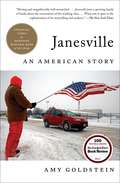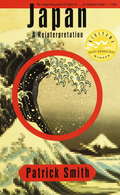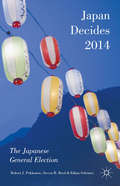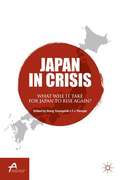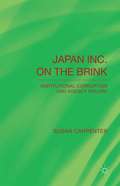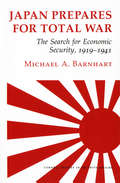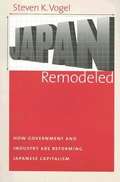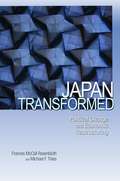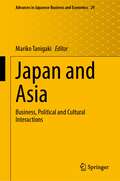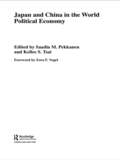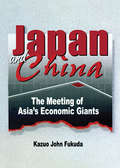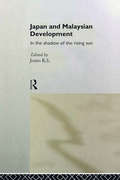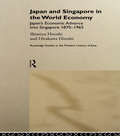- Table View
- List View
Jan Tinbergen (Historical Perspectives on Modern Economics)
by Erwin DekkerJan Tinbergen was the first Nobel Prize winner in Economics and one of the most influential economists of the 20th century. This book argues that his crucial contribution is the theory of economic policy and the legitimation of economic expertise in service of the state. It traces his youthful socialist ideals which found political direction in the Plan-socialist movement of the 1930s for which he developed new economic models to combat the Great Depression. After World War II he was able to synthesize that work into a theory of economic policy which not only provided a lasting framework for economic policy around the world, but also secured a permanent place for economic experts close to government. The book then turns to an examination of his attempt to repeat this achievement in the development projects in the Global South and at the international level for the United Nations.
Janesville: An American Story (A Business Award-Winner)
by Amy Goldstein* Financial Times and McKinsey Business Book of the Year * Winner of the J. Anthony Lukas Book Prize * 800-CEO-READ Business Book of the Year * A New York Times Notable Book * A Washington Post Notable Book * An NPR Best Book of 2017 * A Wall Street Journal Best Book of 2017 * An Economist Best Book of 2017 * A Business Insider Best Book of 2017 * &“A gripping story of psychological defeat and resilience&” (Bob Woodward, The Washington Post)—an intimate account of the fallout from the closing of a General Motors assembly plant in Janesville, Wisconsin, and a larger story of the hollowing of the American middle class.This is the story of what happens to an industrial town in the American heartland when its main factory shuts down—but it&’s not the familiar tale. Most observers record the immediate shock of vanished jobs, but few stay around long enough to notice what happens next when a community with a can-do spirit tries to pick itself up. Pulitzer Prize–winning reporter Amy Goldstein spent years immersed in Janesville, Wisconsin, where the nation&’s oldest operating General Motors assembly plant shut down in the midst of the Great Recession. Now, with intelligence, sympathy, and insight into what connects and divides people in an era of economic upheaval, Goldstein shows the consequences of one of America&’s biggest political issues. Her reporting takes the reader deep into the lives of autoworkers, educators, bankers, politicians, and job re-trainers to show why it&’s so hard in the twenty-first century to recreate a healthy, prosperous working class. &“Moving and magnificently well-researched...Janesville joins a growing family of books about the evisceration of the working class in the United States. What sets it apart is the sophistication of its storytelling and analysis&” (Jennifer Senior, The New York Times). &“Anyone tempted to generalize about the American working class ought to meet the people in Janesville. The reporting behind this book is extraordinary and the story—a stark, heartbreaking reminder that political ideologies have real consequences—is told with rare sympathy and insight&” (Tracy Kidder, Pulitzer Prize–winning author of The Soul of a New Machine).
Janet Ames (D)
by Brian TrelstadThe final case in the series of Janet Ames, looks at the challenges of managing a nonprofit and what to do in the instance of suspected fraud.
Janet Yellen and the Bernanke Fed
by Matthew C. Weinzierl Katrina FlanaganThe unelected Federal Reserve Chairman exerts exceptional influence over the U.S., in fact global, economy. As Janet Yellen prepared to take over the position, she would look back on Chairman Bernanke's tenure during the Great Recession. During that time, Bernanke was attacked by critics from both the left and the right for guiding monetary policy into dangerous territory. Their criticisms echoed arguments Bernanke himself had made with regard to past downturns in Japan and Europe. Were the critics right, or was the Bernanke Fed charting a wise middle course? Instructors may also obtain a Teaching Note, written by this case's author, that provides suggestions for using this case effectively in the classroom.
Janitors, Street Vendors, and Activists: The Lives of Mexican Immigrants in Silicon Valley
by Christian ZlolniskiThis highly accessible, engagingly written book exposes the underbelly of California’s Silicon Valley, the most successful high-technology region in the world, in a vivid ethnographic study of Mexican immigrants employed in Silicon Valley’s low-wage jobs. Christian Zlolniski’s on-the-ground investigation demonstrates how global forces have incorporated these workers as an integral part of the economy through subcontracting and other flexible labor practices and explores how these labor practices have in turn affected working conditions and workers’ daily lives. In Zlolniski’s analysis, these immigrants do not emerge merely as victims of a harsh economy; despite the obstacles they face, they are transforming labor and community politics, infusing new blood into labor unions, and challenging exclusionary notions of civic and political membership. This richly textured and complex portrait of one community opens a window onto the future of Mexican and other Latino immigrants in the new U.S. economy.
Japan
by Patrick SmithThe Japanese are in the process of re-creating themselves--an endeavor they have undertaken at intervals throughout history, always prompted by a combination of domestic and global forces. In this landmark book, Patrick Smith asserts that a variety of forces--the achievement of material affluence, the Cold War's end, and the death of Emperor Hirohito--are now spurring Japan once again toward a fundamental redefinition of itself. As Smith argues, this requires of the West an equally thorough reevaluation of the picture we have held of Japan over the past half-century. He reveals how economic overdevelopment conceals profound political, social, and psychological under-development. And by refocusing on "internal history" and the Japanese character, Smith offers a new framework for understanding Japan and the Japanese as they really are. The Japanese, he says, are now seeking to alter the very thing we believe distinguishes them: the relationship between the individual and society.Timely, measured, and authoritative, this book illuminates a new Japan, a nation preparing to drop the mask it holds up to the West and to steer a course of its own in the world.Jacket image: The Great Wave of Kanagawa, from 36 Views of Mount Fuji (detail) by Katsushika Hokusai. Private collection.From the Hardcover edition.
Japan After Japan: Social and Cultural Life from Recessionary 1990s to the Present
by Tomiko Yoda Harry HarootunianThe prolonged downturn in the Japanese economy that began during the recessionary 1990s triggered a complex set of reactions both within Japan and abroad, reshaping not only the country's economy but also its politics, society, and culture. In Japan After Japan, scholars of history, anthropology, literature, and film explore the profound transformations in Japan since the early 1990s, providing complex analyses of a nation in transition, linking its present to its past and connecting local situations to global developments. Several of the essayists reflect on the politics of history, considering changes in the relationship between Japan and the United States, the complex legacy of Japanese colonialism, Japan's chronic unease with its wartime history, and the postwar consolidation of an ethnocentric and racist nationalism. Others analyze anxieties related to the role of children in society and the weakening of the gendered divide between workplace and home. Turning to popular culture, contributors scrutinize the avid consumption of "real events" in formats including police shows, quiz shows, and live Web camera feeds; the creation, distribution, and reception of Pokmon, the game-based franchise that became a worldwide cultural phenomenon; and the ways that the behavior of zealous fans of anime both reinforces and clashes with corporate interests. Focusing on contemporary social and political movements, one essay relates how a local citizens' group pressed the Japanese government to turn an international exposition, the Aichi Expo 2005, into a more environmentally conscious project. Another essay offers both a survey of emerging political movements and a manifesto identifying new possibilities for radical politics in Japan. Together the contributors to Japan After Japan present much-needed insight into the wide-ranging transformations of Japanese society that began in the 1990s. Contributors. Anne Allison, Andrea G. Arai, Eric Cazdyn, Leo Ching, Harry Harootunian, Marilyn Ivy, Sabu Kohso, J. Victor Koschmann, Thomas LaMarre, Masao Miyoshi, Yutaka Nagahara, Naoki Sakai, Tomiko Yoda, Yoshimi Shunya, Mitsuhiro Yoshimoto
Japan And The United States: Economic And Political Adversaries
by Leon HollermanThe current economic policy debate between the United States and Japan, increasingly assuming the attributes of an adversary proceeding, has roots in divisive issues that have simmered for years. In this first book to specifically address these issues, U.S. and Japanese scholars, government officials, and business executives provide a basis for und
Japan Decides 2014: The Japanese General Election
by Ethan Scheiner Steven R. Reed Robert J. PekkanenCollecting original and high-quality analysis by top scholars from Japan, the United States, Australia, and Europe, this volume analyzes the results of the 2014 election, examining each of the major political parties, central policy issues, campaign practices, and considers how the results were used as a mandate for massive policy reform.
Japan In Crisis
by T. J. Pempel Bong YoungshikThis volume, stemming from the Asan Institute for Policy Studies, observes that for Japan to 'rise again' would mean recovery not only from the triple disaster--the March, 2011 earthquake, tsunami, and nuclear meltdown--but from 20-plus years of economic stagnation, political fumbling, and deterioration in Japan's regional and global influence.
Japan Inc. on the Brink
by Susan CarpenterThis book contends that structural reforms, the essential third arrow in Abe's 'Abenomics', will not happen. As a result, Abenomics is merely a combination of reckless monetary policy and ambiguous fiscal policies which will fail to regenerate Japan's fragile economy and cut sovereign debt.
Japan Post Bank: Current Issues and Prospects
by Akira UnoThis book provides a comprehensive view on how regional financial institutions should be operated in order to restore Japan’s fiscal health. It points out that, even though the Japan Post Bank has been partially privatized, the old mandatory deposit system still virtually exists between the bank and the government. This makes the bank’s asset portfolio heavily weighted toward Japanese government bonds and creates a bottleneck to restoring fiscal health. The book also demonstrates how this system and the low interest rate policy keep the bank’s return on assets (ROA) low and expose the bank to an interest rate risk and credit risk. While shedding light on the true nature of these problems, this work looks into the best ways regional financial institutions can be operated for the sake of regional economic revitalization. The process would involve integrating the three privatized public financial institutions (i.e., the Japan Post Bank, the Shoko Chukin Bank, and the Development Bank of Japan) and splitting their operations into different businesses and regional companies as well as reorganizing more than 100 regional banks. The author analyzes total assets and ROA of different types of financial institutions (public and private financial services) in Japan to obtain an overall view. Then, using ROA as an assessment indicator, he looks into ways to optimize their portfolios to make the most of individual financial assets, especially deposits, from a welfare economics point of view and formulates a theory for optimization. Financial institutions can optimize their ROA by using individual deposits and savings for total optimization to maximize their return on investment. If the share of total assets by type of financial institution is optimized through mergers or vertical integration between different types of financial institutions, and if ROA is optimized overall as a result, the structure of financial institutions by type in Japan can be optimized.
Japan Prepares for Total War
by Michael A. BarnhartThe roots of Japan's aggressive, expansionist foreign policy have often been traced to its concern over acute economic vulnerability. Michael A. Barnhart tests this assumption by examining the events leading up to World War II in the context of Japan's quest for economic security, drawing on a wide array of Japanese and American sources. Barnhart focuses on the critical years from 1938 to 1941 as he investigates the development of Japan's drive for national economic self-sufficiency and independence and the way in which this drive shaped its internal and external policies. He also explores American economic pressure on Tokyo and assesses its impact on Japan's foreign policy and domestic economy. He concludes that Japan's internal political dynamics, especially the bitter rivalry between its army and navy, played a far greater role in propelling the nation into war with the United States than did its economic condition or even pressure from Washington. Japan Prepares for Total War sheds new light on prewar Japan and confirms the opinions of those in Washington who advocated economic pressure against Japan.
Japan Remodeled: How Government and Industry are Reforming Japanese Capitalism
by Steven K. VogelAs the Japanese economy languished in the 1990s Japanese government officials, business executives, and opinion leaders concluded that their economic model had gone terribly wrong. They questioned the very institutions that had been credited with Japan's past success: a powerful bureaucracy guiding the economy, close government-industry ties, "lifetime" employment, the main bank system, and dense interfirm networks. Many of these leaders turned to the U. S. model for lessons, urging the government to liberate the economy and companies to sever long-term ties with workers, banks, suppliers, and other firms. Despite popular perceptions to the contrary, Japanese government and industry have in fact enacted substantial reforms. Yet Japan never emulated the American model. As government officials and industry leaders scrutinized their options, they selected reforms to modify or reinforce preexisting institutions rather than to abandon them. In Japan Remodeled, Steven Vogel explains the nature and extent of these reforms and why they were enacted. Vogel demonstrates how government and industry have devised innovative solutions. The cumulative result of many small adjustments is, he argues, an emerging Japan that has a substantially redesigned economic model characterized by more selectivity in business partnerships, more differentiation across sectors and companies, and more openness to foreign players.
Japan Transformed: Political Change and Economic Restructuring
by Frances Rosenbluth Michael F. ThiesWith little domestic fanfare and even less attention internationally, Japan has been reinventing itself since the 1990s, dramatically changing its political economy, from one managed by regulations to one with a neoliberal orientation. Rebuilding from the economic misfortunes of its recent past, the country retains a formidable economy and its political system is healthier than at any time in its history. Japan Transformed explores the historical, political, and economic forces that led to the country's recent evolution, and looks at the consequences for Japan's citizens and global neighbors. The book examines Japanese history, illustrating the country's multiple transformations over the centuries, and then focuses on the critical and inexorable advance of economic globalization. It describes how global economic integration and urbanization destabilized Japan's postwar policy coalition, undercut the ruling Liberal Democratic Party's ability to buy votes, and paved the way for new electoral rules that emphasized competing visions of the public good. In contrast to the previous system that pitted candidates from the same party against each other, the new rules tether policymaking to the vast swath of voters in the middle of the political spectrum. Regardless of ruling party, Japan's politics, economics, and foreign policy are on a neoliberal path. Japan Transformed combines broad context and comparative analysis to provide an accurate understanding of Japan's past, present, and future.
Japan and Asia: Business, Political and Cultural Interactions (Advances in Japanese Business and Economics #29)
by Mariko TanigakiThis book aims to review the postwar interactions of Japan with Asia. The Japanese factory production system, kaizen, has been shared in Asia. This book collects more diverse topics from Japan’s interactions with China, the Philippines, Indonesia, and Hong Kong. Each chapter provides details on how the business, political, and cultural interactions enrich both sides. The findings are then used to suggest the possibility of a de-facto Asian Community and Japan’s role in the present and post-COVID-19 world.
Japan and China in the World Political Economy (Politics in Asia)
by Kellee S. Tsai Saadia M. PekkhanenTwo powers in East Asia today stand to define the region's economic and commercial future: Japan, which rose in a spectacular industrial burst to become at present the world's second largest economy; and China, which is rapidly advancing towards a market economy under the watchful eye of the world. While much has been made of Japan and China’s particular economic institutions and developmental paths, few works analyze them in a comparative framework. Including contributions from leading academics, the text focuses on the period from the 1980s to the onset of the 2000s, reviewing the experiences of Japan and China across the areas of development, trade, investment, finance and technology. Drawing on a combination of official documents, economic statistics, case studies and original fieldwork, this book will give political scientists, political economists, business concerns, and policy analysts a firmer grasp of the role Japan and China stand to play in the world political economy.
Japan and China: The Meeting of Asia's Economic Giants
by Erdener Kaynak Kazuo. J FukudaJapan and China: The Meeting of Asia’s Two Economic Giants analyzes the new and changing relationship between the two nations and the rest of the world that may shape a new economic landscape for Asia in the 21st century. Managers and employees of multinational firms, as well as students interested in international business, will learn about the cultural ties between the two countries and how traditions have shaped management methods and work ethics. Understanding the cultures and traditions of each country will help you improve business relations with Japanese or Chinese firms. It will also help you compete with these firms in the international business arena. Japan and China: The Meeting of Asia’s Two Economic Giants is based on an extensive survey of current literature, personal observations, and case studies researched by the author. Containing first-hand information on the interworkings of old and new Japanese and Chinese business practices, this book unveils some of the myths behind Japanese-style management and Chinese business methods. In light of increased cooperation between the nations, Japan and China: The Meeting of Asia’s Two Economic Giants discusses some of the barriers to business between the two countries and what effects these barriers can have individually on China, Japan, and other nations. In addition, the text contains suggestions for further improvement of business relations between China and Japan by examining: China’s current drive to learn and adapt some of the West’s modern management knowledge and technology and to re-examine ancient military strategies relating to business ways to improve working relations between Japanese managers and Chinese workers how to make Japanese-style Human Resource Management (HRM) understandable to other countries the effect that disappearing Japanese style management practices, such as lifetime employment and seniority-based promotion/pay systems, have on Japanese businesses societal differences that add difficulty to business relations between China and JapanFeaturing unique, first-hand accounts and insights into Japanese and Chinese business practices, Japan and China: The Meeting of Asia’s Two Economic Giants will keep you informed of the changing world of international business as it approaches the 21st century.
Japan and Malaysian Economic Development: In the Shadow of the Rising Sun
by Jomo K. S.The Japanese presence in Southeast Asia is treated variously with either suspicion or encouragement. Japan and Malaysian Development critically assesses different dimensions of Japan-Malaysia economic relations. The work presents a balanced collection of essays examining Japanese involvement in Malaysia. The volume also discusses the impact and consequences of Malaysian Prime Minister Mahathir's 'Look East' policy, which advocated greater emphasis on trading relations with Japan.
Japan and Singapore in the World Economy: Japan's Economic Advance into Singapore 1870-1965 (Routledge Studies In The Modern History Of Asia Ser.)
by Hiroshi Shimizu Hitoshi HirakawaThis pioneering work examines Japan's economic activities in Singapore from 1870 to 1965. Drawing upon a wide range of published and unpublished sources, the authors shed new light on issues such as:* prostitution* foreign trade by Kobe's overseas Chinese* fishermen in the inter-war period* Japanese economic activities during the Pacific War* Japan
Japan and a New World Economic Order (Routledge Library Editions: Japan)
by Kyoshi KojimaPresident Nixon’s new economic policy of August 1971, aggravated by the oil problem since October 1973 caused chaos and uncertainty in the international trade and currency system. There were fears of another 1930s style depression. In addition, a world food shortage and strident claims by developing countries for perpetual sovereignty over resources added another set of difficulties. This volume, written from Japan’s standpoint, suggests a new direction for the world and regional economic order. The book tackles two major issues in international economics: Firstly, traditional international trade theory aims only at static maximization in the use of world human and material resources, but, the author stresses more attention should be paid to such dynamic or developmental elements as population growth, immigration, natural resource development, improvement in transfer of technology, economies of scale, direct foreign investment and economic integration in order to create development centres or sectors in the world economy. Secondly, the author discusses how to combine a global and regional approach to economic integration.


